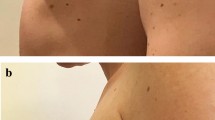Abstract
Introduction
Whereas body-contouring surgery after massive weight loss in women receives much attention, little attention has been devoted to accentuating the male physique. Male patients after massive weight loss often suffer from redundant skin and soft tissue in the anterior and lateral chest region, causing various deformities of pseudogynecomastia. The authors present their approach to high-grade pseudogynecomastia correction with preservation of the NAC on an inferior dermoglandular pedicle with transverse scar only closure and without any meaningful liposuction.
Materials and Methods
A description of comprehensive pseudogynecomastia correction with the aforementioned technique followed by review of 58 consecutive patients operated on in our clinic from January 2017 to June 2018. Epidemiological data such as age, weight, height, body mass index (BMI), weight loss, and the medical history of each patient were collected. All patients were photo-documented preoperatively and postoperatively in a standard manner. During the operation, weight of resected tissue and operative time were noted.
Results
Fifty-eight patients were operated on in a single stage. In our series, one patient had unilateral partial necrosis on nipple–areola complex, and two patients had minimal to moderate amounts of hematoma which were followed up without intervention. We did not encounter any infection-related complications or skin redundancy in our patients. Out of 58 patients, 55 of all the patients were highly satisfied with the aesthetic results. Three patients were mildly satisfied with the results, but they stress that moderate scar widening was the reason for the displeasure, not the definition of the chest which was deemed as satisfactory like the rest.
Conclusion
Our technique obviates the need for skin resection in a second operation, allows immediate skin recontouring, and provides a viable nipple–areola complex at the desired location. The patient does not have to suffer prolonged stress while awaiting skin retraction and is protected from a second dose of anesthesia and hospitalization.
Level of Evidence IV
This journal requires that authors assign a level of evidence to each article. For a full description of these Evidence-Based Medicine ratings, please refer to the Table of Contents or the online Instructions to Authors www.springer.com/00266.










Similar content being viewed by others
References
Gusenoff J-A, Coon D, Rubin J-P (2008) Pseudogynecomastia after massive weight loss: detectability of technique, patient satisfaction, and classification. Plast Reconstr Surg 122(5):1301–1311
Cardenas-Camarena L et al (2017) Surgical masculinization of the breast: clinical classification and surgical procedures. Aesthet Plast Surg 41(3):507–516
Rohrich R-J, Ha R-Y, Kenkle J-M et al (2003) Classification and management of gynecomastia: defining the role of ultrasound-assisted liposuction. Plast Reconstr Surg 111:909–923
Mladick R-A, Hunstad J-P, Pitman G-H et al (2006) Practice forum: malebody contouring. Aesthet Surg J 26:307
Hodgson E-L, Fruhstorfer B-H, Malata C-M (2005) Ultrasonic liposuction in the treatment of gynecomastia. Plast Reconstr Surg 116:646–653
Beckenstein M-S, Windle B-H, Stroup R-T Jr (1996) Anatomical parameters for nipple position and areolar diameter in males. Ann Plast Surg 36:33–36
Shulman O, Badani E, Wolf Y et al (2001) Appropriate location of the nipple–areola complex in males. Plast Reconstr Surg 108:348–351
Gusenoff JA, Coon D, Rubin JP (2008) Pseudogynecomastia after massive weight loss: detectability of technique, patient satisfaction and classification. Plast Reconstr Surg 122(5):1301–1311
Ziegler Ulrich E et al (2018) Modified treatment algorithm for pseudogynecomastia after massive weight loss. Ann Plast Surg 81(3):290–294
Stoff A, Velasco-Laguardia F-J, Richter D-F (2012) Central pedicled breast reduction technique in male patients after massive weight loss. Obes Surg 22(3):445–451
Thiénot S, Bertheuil N, Carloni R et al (2017) Postero-inferior pedicle surgical technique for the treatment of grade III gynecomastia. Aesthet Plast Surg 41(3):531–541
Funding
No funding was received for this study.
Author information
Authors and Affiliations
Corresponding author
Ethics declarations
Conflict of interest
The authors declare that they have no conflict of interest.
Ethical Approval
The protocol of the study was approved by the Institutional Review Board.
Informed Consent
Informed consent has been taken from each patient to use photos for academic purposes.
Additional information
Publisher's Note
Springer Nature remains neutral with regard to jurisdictional claims in published maps and institutional affiliations.
Rights and permissions
About this article
Cite this article
Diyarbakirlioglu, M., Ercan, A. & Dogan, Y. Correction of High-Grade Pseudogynecomastia After Massive Weight Loss: Modified Inferior Dermoglandular Pedicled Transverse Scar Reduction. Aesth Plast Surg 44, 435–441 (2020). https://doi.org/10.1007/s00266-019-01477-4
Received:
Accepted:
Published:
Issue Date:
DOI: https://doi.org/10.1007/s00266-019-01477-4




